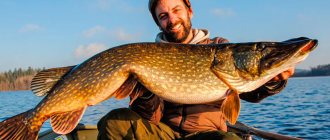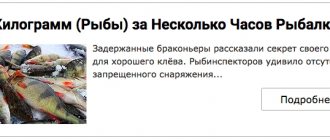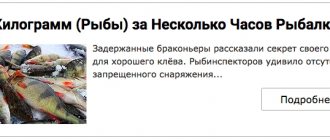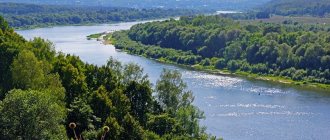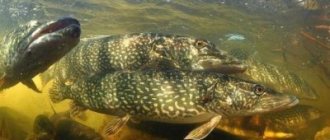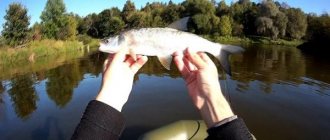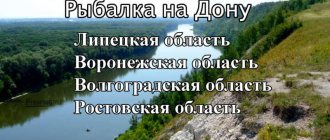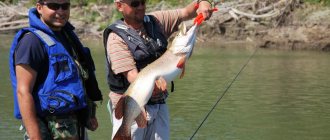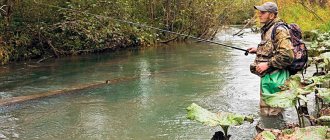The territory of the Pskov region has long been famous for its lakes and rivers. There are more than three and a half thousand lakes in the region alone. One of them, Chudskoye, became famous throughout Europe and took third place in size. The region's lakes are famous for their rich fish resources.
More than forty-two fish species can be found in reservoirs. Excellent fishing is also possible on the rivers of the region, the main of which are the Velikaya, Issa, Cherekha, and Lovat.
Features of fishing in the Pskov region
Due to the fact that the reservoirs of the region are rich in plankton, there are quite a lot of fish in them. However, she shows whims and quite often changes her eating habits. When going fishing, it is recommended to read the advice of experienced fishermen who often visit these places. Each body of water in the Pskov region has its own characteristics. For example, on Lake Peipsi, the peak of fishing activity occurs in the winter months.
You are more likely to catch a perch at the very beginning of winter, with slight frosts in clear sunny weather. Large perch come closer to lunch; they bite well on the worm. Lake Pskov pleases with a good catch of perch and roach all year round.
But in recent years, smelt very rarely gets hooked. As soon as severe frosts set in, active burbot biting begins. Fishing on the Lovat River differs from other places in the presence of fairly large catfish.
Despite the fact that in other places the catfish prefers depth, on the Lovat River it very often gets hooked on fast riffles between stones. The food preferences of the catfish here are small minnows or lampreys. By familiarizing yourself with the peculiarities of fishing in a particular body of water before fishing, you can ensure yourself a good catch and wonderful impressions.
FishLove stores: fishing with love
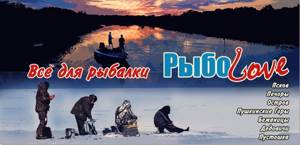
Hello, fisherman!
If you're reading this, it means we didn't waste our time.
We are sure that for you fishing is not just a hobby, it is a whole separate world in which you can relax and unwind after hard work or just in your free time. When you come to a pond, you merge with nature, feel its measured running and adapt to its rhythm. It doesn’t matter which way you fish, float, spinning rod, feeder - it doesn’t matter, you rest, breathe deeply in the morning at dawn, on a bright or rainy day, in the evening at sunset, at night under the stars, in winter, spring, summer, autumn, that’s not the case either. what is important, the main thing is that you are in the right place at the right time, and this is your time, the time when you can be alone with nature, with your thoughts, or with your family, with friends, away from noisy cities, all this everyday routine, throw off the shackles of fatigue, get your dose of adrenaline. Everyone needs a rest.
We understand you and strive to ensure that everyone can get from us what they need here and now, of course, if we list all the products, this article will not be enough, so just come and visit us.
By the way, we also have a small shoe store for fishing and hunting in Pskov.
Nordman is the only store of this format in the city!
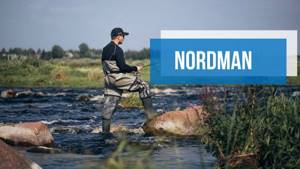
Store addresses:
• Pskov, st. Yana Fabritsius, 5, “RyboLove” store. Telephone • Pskov, st. Yubileinaya, 36, “RyboLove” store. Phone 8 (8112) 58-80-30 • Pskov, Rizhsky Prospekt, 44, “RyboLove” store, TC “Mayachok”. Phone 8-911-699-63-71 • Pskov region, urban-type settlement Bezhanitsy, st. Friendship, “RyboLove” store. Phone 8-911-882-94-07 • Pskov region, town Pushkinskie Gory, st. Pushkinskaya, 13a, “RyboLove” store Phones: 8(81146) 23-293, 8-911-355-13-46 • Pskov region, Pechory, st. Rizhskaya, 4a, “RyboLove” store. Phone 8-911-393-66-17 • Pskov region, Pustoshka, st. T. Ptichkina (at Magnit), RyboLove store. Phone 8-911-360-60-94 • Pskov region, Ostrov, st. 1 May, 19a, “RyboLove” store. Phone 8-911-392-98-64 • Pskov region, Dedovichi village, st. Oktyabrskaya, 39 (Mn. Energetikov) “RyboLove” store. Phone 8-911-896-76-11 VK group: https://vk.com/rybolovepsk • Pskov, st. Yubileinaya, 36, Nordman shoe store. Phone 8 (8112) 58-80-30. VK group: https://vk.com/nordmanpsk
Fishing on the rivers
Let's look at the most popular places for fishermen. These are the rivers:
- Plus.
- Great.
- Issa.
- Lovat.
- Blueberry.
- Nizhnyaya Belka.
Plyussa River
It is a great place not only for fishing, but also for a great family vacation. The coast is simply dotted with tourist centers, but if you wish, you can easily find free, almost deserted places. Access to the water is excellent.
The river is home to perch, burbot, gudgeon, roach, bream, pike, catfish, rudd, golden carp, brook trout, and ide. In the summer months, an abundance of aquatic vegetation flourishes in the river, and the bottom is strewn with snags. In places with strong currents you can find a lot of bleak and roach. The most convenient way to fish is with a spinning rod from the shore. Regular fishermen are often pleased with kilogram pike on a hook and half a kilogram of ide.
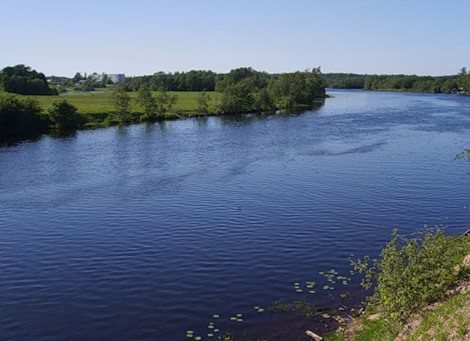
Great River
Length - four hundred and thirty kilometers. Velikaya has the title of the largest river in the region. The bottom of the reservoir is mostly rocky. The most catchy places are in the lower reaches. Pike, burbot, roach and perch are always actively biting. Sometimes you can see catfish, however, this happens quite rarely.
Spring and autumn are great times to catch pike perch. When going fishing, you should remember that the main habitat of fish is in creeks and on bends, but fish do not stay long in straight sections of a reservoir.
Near the mouth the small but incredibly tasty smelt bites well. Fishing using jigs and wobblers pleases with a not too active bite, but pike bite well on a spinner. Perch in these places prefers worms. Bloodworms are also perfect for fishing.
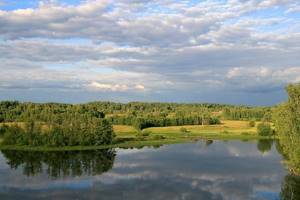
Issa River
Shallow (average depth is 2 m), with fast rapids and the presence of deep pools. Pike, chub and perch are found in sufficient quantities in the river. Fishing here is best done from a boat using a spinning rod. Pike bites well on small perches. The average size of a predator caught on a hook is slightly more than one kilogram.
But perches go for the worm, but they are rarely pleased with their size. Mostly you come across specimens that do not exceed three hundred grams. You can catch trophy specimens of chub on Issa. It is found in pike areas - a small bay, slightly fenced off by grass. Fishermen use a wobbler to pull out one and a half kilogram beauties. Pike bite perfectly in chub habitats - on a stretch with minimal current. This is an interesting feature of the reservoir.

Lovat River
It is inhabited by pike perch, catfish, asp, bream, ide, burbot, tench, pike, rudd, bleak, roach, perch, and ruff. It is very rare to see one-pound trout. Despite the fact that bleak is caught in the hundreds, the number of this type of fish is only increasing every year. In late spring, bleak bites on absolutely any bait at any time of the day. Fishing occurs without the use of a sinker. The bleak takes bait from the surface of the reservoir.
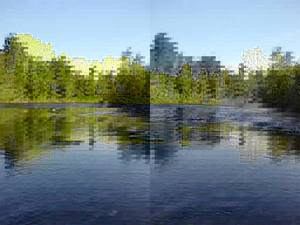
This continues until the beginning of summer; as the air temperature rises, the bleak bite can be called average. It is being replaced by good catches of roach and perch. Fishermen mainly use maggots, bread circles and semolina for fishing. Also on Lovat there are large specimens of catfish. They can be found on the rifts. Both float and bottom tackle are used for fishing. Gudgeon fishermen caught catfish weighing slightly more than seven kilograms.
At night, catfish are best attracted to small frogs. If there is a confident bite, you should immediately hook the fish. It is worth remembering that even a small catfish offers decent resistance when fishing.
Nizhnyaya Belka
The length of the reservoir is forty-one kilometers. There is beautiful nature everywhere, clean water and many bushes and trees along the banks of the river. The main hooked catch in these places is pike, bream, tench, pike perch and ide. It cannot be said that the river is fraught with trophy specimens.
Unfortunately, despite the good weighty catches, the fish predominate in medium-sized or even small-sized reservoirs. But the bite here is uninterrupted and is famous for its enviable consistency. Tench is caught in the spring on young shoots of reeds; the pieces should be small in size.
The rest of the time, the working bait is bloodworm, pearl barley, dough and, of course, maggot. It is best to fish from the shore in quiet backwater areas. Pike perch bites well on fry both in the summer months and in winter.

Features of catching pike in winter with a spinning rod on a small river
The beginning of today's winter turned out to be abnormally warm. During the day the temperature is constantly above zero, only at night there are slight frosts - the fishing season with spinning rods in open water does not have to end. Starting in December, when daylight hours become very short, I don’t fish at all on large rivers and reservoirs exposed to piercing cold winds, but I fish for pike with a spinning rod from a boat and from the shore on medium-sized lakes and small rivers. I especially like to fish on small rivers that are easy to read for the experienced eye, where everything is very compact, nearby and understandable, and most of them are deserted and homely, quiet and comfortable - even in bad weather.
Rarely do I manage to visit my small river, which I fell in love with a dozen years ago, and each such outing is always remembered for a long time. This year was dry - most reservoirs became very shallow, and some lakes even practically dried up - the same thing happened on small rivers.
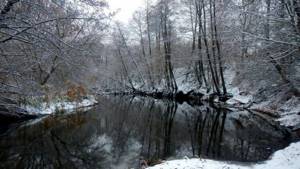
My small river suffered from drought, like all rivers similar to it, plus usually almost every autumn before freeze-up, all the reservoirs of the local cascade drop their water levels significantly. And since my river flows into one of these reservoirs, it has become very shallow - I don’t remember such an extremely low water level in any of the previous seasons.
On the river riffles, where previously there was at least one and a half meters of depth, the boat now rubs against its bottom - and it was necessary to drag it to a deeper place. It became much more difficult to overcome the old rubble of trees that had fallen long ago scattered along the river, especially at turns or shallows - through some such places the boat had to either be carried along the bank, or look for at least some kind of passage in the rubble into which the boat could be squeezed . And if the branches of the lying trees were not too thick, a small hacksaw was very helpful in overcoming such obstacles.
Carrying a boat with things and equipment along a bank covered with impenetrable forest was an almost impossible task - not only were the banks very steep, but one also had to climb onto it through slippery clay.
But fishing, of course, became easier - due to low water, at least some large pike concentrated in deeper places, large and not so big holes.
Traditionally, the largest pike stood under the deepest rubble, from where you still need to be able to lure the toothy one out - and this did not always work. In general, I have long noticed the specifics of my small river - this reservoir is very capricious in terms of the activity of the pike inhabiting it. Here you can easily remain without a catch even with many days of stable atmospheric pressure and ideal weather for fishing, and still have a great catch. But we’re not even talking about that, but about the size of the pike being caught.
The most common pike in catches is the so-called “sports pike”, weighing up to one and a half kilograms maximum. But there are days when large specimens - for reasons known only to them - come out of their rubble to feed - and then you can catch several good pike of 3 - 5 kg: for a small river these are real trophies. And taking into account the strength of the pike that lives on the river current, whose body consists only of muscles, such a specimen resists when fishing so that the adrenaline will last for a long time. And what’s interesting is that a small pike and a large one are never caught on the same day; I can’t understand why, no matter how hard I racked my brains: either small pike or trophies, “assorted” never happened.
In winter, on most reservoirs in the morning you may not see a single pike bite, and the toothy one “wakes up” almost at noon, when the sun warms up and the air warms up at least a little. But on my small river things are completely different.
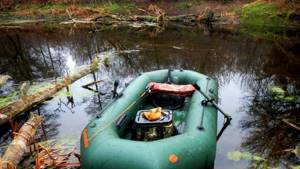
The water level in my river in winter is so low that in some places you can ford it
The key condition for successful fishing is a certain illumination of the reservoir: the greater it is, the less active the pike is, this has been confirmed by many years of trips to this river. Moreover, at any time of the year, be it spring, summer, autumn or winter, the most productive hours are always the early morning hours, when the sun is still low. True, there are also short-term daytime pike exits, but you still need to get to them, i.e. at this time it is necessary to catch, and not, say, fight to overcome another blockage or have a snack in a boat.
For example, the banks of the river in the place where I most often fish are steep, high and wooded: as soon as the luminary appears above the forest and illuminates the surface of the reservoir, the bite instantly disappears. Moreover, this is observed even in cloudy weather - then the illumination also increases, but barely noticeably, however, for pike this apparently plays a decisive role, and it is very sensitive to this factor.
Likewise, in those sections of the river where it flows along a plain and the banks are covered with a tall wall of dense reeds, as soon as the sun rises above the reed forest, you can immediately forget about the bite, unless you accidentally throw a toothy wobbler right under your nose.
However, being on the right section of the river at the right time is still not enough to catch a pike, even if your box is full of the most catchy baits. The most important thing is to present it correctly and accurately to the predator, selecting the wiring, and arouse her interest: then the pike will respond, and all your efforts will be rewarded.
My partner and I have had this happen more than once: he goes upstream, I go downstream, the places are equally fishy, i.e. we are in approximately equal conditions. And we often use the same models of wobblers, but it happens that I catch, but he doesn’t, or I catch him with a large score. And all because I analyze the situation with the activity of the pike in time - and before its activity drops to zero, I try to select the wiring. For example, a fish in cold water does not want to react to a jerky retrieve, even sluggishly and with long pauses.
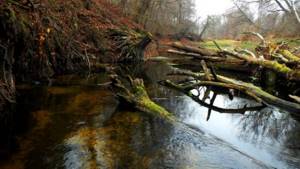
You need to somehow squeeze a boat between these rubble and the shore.
Then I try a stop-and-go retrieve and start fishing. Exits, strikes, realized bites - life is in full swing, while your partner does not change anything in tactics - and as a result he catches practically nothing. Yes, fishing is hard work, and sometimes each pike has to be tortured, but it’s all the more pleasant to know that you still managed to find the key to the pike’s mood.
It is also very important to accurately place the wobbler at the intended point like a sniper - this is almost half the success, because if a snag occurs, if you hang the bait on branches hanging over the water or if it picks up grass on the tees, then the place will be completely ruined.
Usually, when you find a more or less active pike, the bite happens on the first or second twitch, but it also happens that you have to move the wobbler along the same corridor up to ten times or more. Sometimes this is the only way to irritate a passive pike (you then take it in your hands, and small leeches literally fall off the body in whole clusters), forcing it to decide to grab.
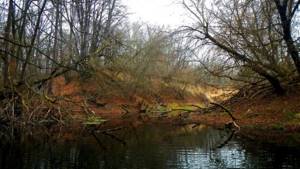
All the pike fell into deep places - I had several pike bites in this hole
At this time, the algae have long died off and sank to the bottom, so you can freely cast in any direction. I try not to waste precious time in shallow water areas - pike also hang out here, but usually they are very small and of no interest. But I try to fish any pits and pits carefully, but I still rely on active fish - such fishing is much more dynamic and in most cases more effective.
All more or less large pike roll into these deep areas, and often even in a small hole you can get several bites. If small pike stay mainly on the edges and at the exits of holes, then large specimens always gravitate towards snags and rubble, and the more impenetrable they are, the greater the chance of catching a trophy here. Usually a bite occurs when you methodically move the wobbler many times along the blockage - a large pike cannot stand it, flies out from under it, grabs the wobbler with a blow and immediately dives under the saving branches.
Our task in such cases is to react instantly and prevent the pike from going into the support, using the full power of the tackle. But if you hesitate just a little, the whole thing ends right away, and you can lose the bait. The pike pulls under the rubble with such frantic force, pressing with all the weight of its body, that in almost half the cases it emerges victorious from this confrontation.
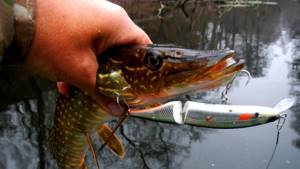
A small pike appreciated the homemade wobbler compound
The tactic that works best is to throw the bait into the shore, and you need to try to place the wobbler right next to the snags lying near the water's edge, while managing not to catch the bait (although this also happens). You should precisely fish for every snag, every “pocket” between the trunks lying in the water - you never know exactly where the pike is standing and where it will attack our wobbler from. Well, the clear water of a winter river makes it possible to watch a pike attack - it’s like watching an action movie, and this adds a fair amount of adrenaline to fishing.
Winter pike is capricious and lazy; it will not chase a fast-moving wobbler. If in the warm season the wiring can be done more energetically, and pauses in most cases can be minimal, now it’s not so easy to deceive the toothy one. And although in winter the same minnows with a length of 11 - 13 cm are in use, the wiring now needs to be delicate and slow, with frequent pauses lasting up to ten seconds. Sometimes, during such a long pause, the line conveys how the pike seems to pinch the wobbler, testing it with its teeth, and then leads it to the side - and if you don’t hook it at this moment, then there are many derailments.
When fishing in winter, I noticed another interesting feature: a pike may be present at the point, but until you present the bait to it at a certain angle, it will not react to it. For example, you can fish a blockage, passing the wobbler parallel to the trunks lying in the water many times, but you won’t even see a bite, but as soon as you throw the bait exactly perpendicular to the trunk, the pike immediately attacks it.
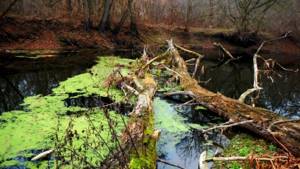
It is precisely under such a windbreak that the largest pikes stay
Having fished on this river for many seasons, I have developed many points where one or two pike on duty are guaranteed, but sometimes the predator bites in completely unexpected places - and this is a pleasant bonus.
A winter day is fleeting, so you shouldn’t carry a lot of boxes with bait with you: you won’t try everything anyway - it’s better to stick to old, proven models. Usually I have enough of a small double-sided box, and in it - a pair of minnows with a meter depth, a pair with a one and a half meter depth, one or two deep minnows for fishing holes, a couple of three joints with different depths and two or three sinking minnows for places with current.
This set of wobblers is enough to adapt to all situations that arise during fishing - a larger number of baits does not give anything good, except the temptation to thoughtlessly change one model for another. In this case, we waste precious time and catch with minimal effect.
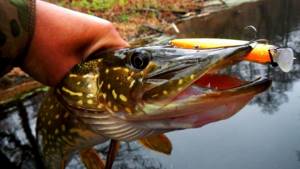
Minnows work even on passive pike on a long pause
Recently, I became interested in the handmade wobblers of one master, very well made and excellent for catching pike, and on a couple of fishing trips I decided to conduct an experiment using only his models. Interestingly, by playing with the accessories, it was possible to turn these wobblers into slowly rising, suspending or sinking ones, adjusting them to the fishing conditions: for example, I loaded two floating minnows under neutral buoyancy, and made the joint sinking.
The narrow-bodied minnow had a very lively three-dimensional “game” on a jerk retrieve, the tall-bodied model (a hybrid of a minnow and a shad) played more interestingly when twitching, and the teammate on twitch broke his whole body, falling on one side or the other.
I pinned my greatest hopes on the composite minnow: firstly, sinking models in rapids or in places with changing depth along the way are the most versatile. In addition, it is the liners that work well on low-active fish - on twitch they move forward very slowly, giving the pike more time to think, and if they also have pauses, then this is generally a terrible weapon if the bite is bad.
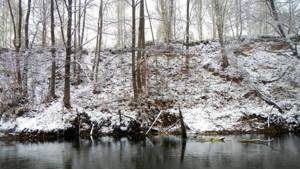
A blockage under the shore, from under which a large pike attacked the wobbler - as a result, an unbent hook and an offensive escape
...My partner and I arrived at the place as soon as it began to get light - as I mentioned above, the morning hours on the river are the most productive, regardless of the time of year. We quickly dropped the boats into the water and went in different directions: I went downstream, and my partner went upstream. I attach a compound minnow to the leash and make five traditional casts in a small creek just below the place of our dumping - there was always a medium-sized pike there.
On the second cast I earned a kill of a pike, a little lower another fish attacked the wobbler, but missed. The conclusion is that there is pike, but it is inactive: therefore, it’s hard fishing again – you will have to work hard to catch something. The water level turned out to be unusually low, so difficulties began literally from the very first blockage: where the boat had previously passed without much effort, now it had to be squeezed into a narrow corridor between a thick branch and a steep bank. Having done this half-heartedly, I encountered another obstacle - in a shallow run with the current, where there had previously been a decent depth, I managed to land the boat on its belly.
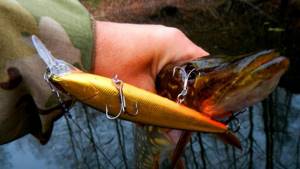
In winter, minnow suspenders are great for catching pike with deliberately long pauses.
Having pushed the boat into a deeper place, I sail further - interesting places begin a little further downstream, there are a series of small pits and a couple of more or less deep holes. I almost never use an anchor here, although it is always with me in the boat: either I fish by pressing the side against one of the banks, or I rest against some kind of blockage. Tree trunks hold the boat well, especially since the current in winter is barely noticeable, and I anchor only in large holes, usually in the center or on the edge.
Here is the first pit, twenty-five meters long, blocked from above and below by fallen tree trunks: under one bank there is a current, and under the other, quieter and in the water lies a pile of snags.
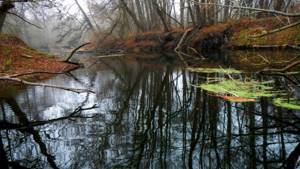
One of the catching points on the river is a hole filled with driftwood
I anchor the boat to the shore with the current and throw the bait under the opposite one, trying to place the wobbler directly against the trunk lying in the water. The first couple of jerks - and here is a pike up to a kilogram on the tees: the fish hardly resists and is all covered with small green leeches, which indicate that it is passive and almost does not move. But even so, the wobbler thrown under her nose still tempted her to attack - which means there is hope for bites.
I shoot fan-shaped casts into the pit, but the predator is silent. I move the boat a little lower downstream - and immediately pull out the same pike, and also in the first jerks, the Beauty is also covered with small leeches - I photograph the fish and release it on its way: we need to swim further, where there are many more interesting places. But problems arose with overcoming the lower tree bordering the pit: the trunk was narrow, but there was no passage between it and the shore - we had to climb out onto land and drag the boat over the obstacle.
You can imagine what it’s like to climb onto a slippery thin trunk and, balancing on it like a real acrobat, drag a boat over it, every second risking falling into the icy water. But everything went well - however, I was already steaming. But not far away a turn awaited me with a small hole and a picturesque blockage, from under it my wobbler was attacked by a huge pike, which, however, got away, crushing two powerful Japanese treble hooks like a toy.

The pike is covered in leeches, which indicates its low activity
I stand near the shore, under which there is a weak current, and make a cast to the rubble: the whole trick is not to catch the wobbler on trunks invisible under water, of which there are plenty piled up here. And remembering whether somewhere or another tree lies under water does not help here - every spring, a stormy flood moves the trunks along the bottom, so you always need to be on the alert.
Over the years of fishing in such “firewood” I have learned to do without unhooking - I know one little trick. You lead the wobbler, and as soon as you feel that it is buried in something, you immediately stop wiring - at the same time, you need to unlearn how to automatically respond by hooking. If it is a pike, it will immediately make itself felt with resistance, and here you can already hook, although you don’t have to do this: a bait equipped with two or three tees gives the fish little chance of getting away. Well, if you’re unlucky, you need to treat it philosophically - it means it simply wasn’t your fish.
If, upon contact with an obstacle, you perform a strong hook, the tee will automatically drive even deeper into the wood, which is extremely undesirable. But if you swim in a boat past the hook and pull in the opposite direction, the wobbler is usually easily freed from underwater captivity.

Sometimes you have to wade through such windfalls on the river
Having processed the blockage from different angles with a dozen or two casts, I move to the other bank and cast to the exit of the hole, to the top of the edge - usually this is a win-win option. This is what happens - a pike grabs a wobbler on a dump: a short struggle, then a photo shoot - and the beauty swims home to fatten up. I swim further, passing a shallow area with a fast current, but along the way I make a test cast into a small pit in a meter deep. Wiring - no reaction, I had already pulled the wobbler out of the water - and then a decent pike came to the surface after it, and then disappeared into the pit with splashes.
Finally, I’m in a compact hole littered with trees - here I’ve always caught from one to three pikes, I just need to change the position of the boat and shoot the hole with wobblers from different angles. And again the exit from the pit worked - a pike weighing about one and a half kilograms grabbed the minnow during the pause, and sat down without a blow, completely unnoticed: and again whole hordes of leeches on the body of the predator. I swim to the largest hole on my way - here I need to fish longer, because... There is always a lot of pike here, mostly under half-submerged tree trunks.
At the entrance to the hole I earn a decent catch, a little further on there is another one - it’s immediately clear that the pike’s activity is very low, because it simply butts the bait with its closed mouth. I went lower, but the path was closed there - I came to such rubble that just the thought of overcoming them made me feel sick, so I decided to slowly, with fishing, go back upstream. Skimming all the pits and pits along the way, I take out four more pikes and earn a catch of about three kilograms of fish right next to the side of the boat - it’s annoying, of course, but what can you do.
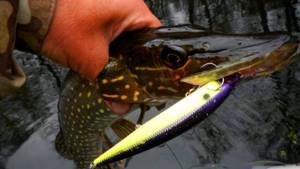
Accurate casting of a wobbler, a couple of pulls and a pike on the hook
Swimming up to our gathering place, I meet my partner - he only had a couple of small pike in his catch: he caught approximately the same models of wobblers as me, but the point here is not at all in the wobbler, but in the way it is used serve the pike...
In winter, almost every fishing trip on this small river turns out to be laborious - and even if the local toothy trophies are not too large, this body of water still attracts you like a magnet with its beauty and silence. And the local pike always asks new riddles, which are very interesting to solve!
Andrey Shvets
Fishing on the lakes
The most popular places are:
- Chudskoe.
- Blue.
- Sour.
- Maidenish.
Lake Peipsi
Its length is ninety-six kilometers. The lake contains an incredibly rich and diverse plant and fish world. There are about thirty-seven species of fish living in this area.
It is excellent to catch roach, perch, crucian carp, ide, whitefish, vendace, bream, pike perch, and pike. However, the presence of captured specimens is not widespread, but is most likely an exception to the rule. Pike bite mainly in kilogram sizes, roach 200-300 grams, pike perch in the kilogram area.
Occasionally you can find two-kilogram predators on a hook. In winter, a good bite is ensured by bait in the form of bloodworms; in summer it must be a fry. You can fish both from the shore and from a boat.
Lake Kisloye
Beautiful nature surrounds the lake, which is home to a fairly large number of fish. Pike, perch, tench, crucian carp, carp, verkhovka, loach, burbot, and pike perch are found in large numbers.
It is very rare to see the endangered species of peled. The reservoir is systematically stocked with fish. Carp and crucian carp bite very actively. Crucian carp go for a sandwich, and carp prefer corn, dough, semolina. The most catchy free places are on the shore near the rocks near the railroad tracks. The carp is very large. Fishermen boast of catches of fifteen kilogram carp.
Maiden Lake
Picturesque places with abundant forest plantations, fields and swamps along the banks. There are broad-toed crayfish, crucian carp, tench, pike, perch, roach, rudd, loach and burbot. The bottom in the center of the reservoir is covered with silt, near the shore there is sand, silt and stones.
They are mainly caught with spinning rods from the shore. Carp actively takes corn, boilies and semolina, crucian carp prefers maggots and foam balls. Burbot loves small frogs, insect larvae, fry and a variety of worms.
Paid fishing
Some people prefer to go fishing as wild people, while others prefer convenience and good conditions. To each his own, as they say! For lovers of fishing with amenities, there are many fishing bases in the Pskov region.
The most popular among them are:
- Guest house "Kapanovo".
- Recreation center "Volyn".
- Base "Forest Harbor".
Guest house "Kapanovo"
Located on the shore of Lake Sebezh. The polite staff is happy to accommodate up to eight visitors in the house. Meals are available upon request. It is possible to use the bathhouse, which is located on the shore of the lake. Renting a house will cost seven thousand rubles per day.
Fishing is permitted both in winter and summer. The lake is home to pike, crucian carp, tench, ide, roach, bream, grayling, pike perch and perch. Very often, fishermen manage to catch trophy specimens of perch and bream. Boat rentals are available.
Recreation center "Volyn"
This is a real paradise located on the peninsula of Lake Žižice. Hospitable staff, well-equipped rooms, picturesque nature, and the opportunity to go hunting or fishing. What else is needed for happiness? You can rent any number you like.
The cost for a three-day stay will range from three to fifteen thousand rubles, depending on the number of places. Accommodation for children under five years of age is not paid. By paying for accommodation you have the opportunity to use:
- Car parking.
- Gym.
- By boat no more than 1 hour per day.
- Football field.
- Volleyball field.
- Roller.
- Get breakfast.
Lunch and dinner are paid separately and amount to at least two hundred and fifty rubles. The lake is home to asp, roach, ide, pike, bleak, catfish, pike perch, gudgeon, bream, rudd, tench, burbot, and crucian carp. Boat and fishing equipment rentals are available. You can also purchase bait and bait on site.
Base "Lesnaya Gavan"
Located near Lake Spaster. This place is perfect for those who want to combine fishing with an active family vacation. In the reservoir there is a ruff, which is caught with a fly rod. For entertainment, the base offers:
- Boating and catamarans.
- ATV racing.
- Beach.
- Attractions of the "Water Town".
- Balloon flights.
In winter, you can go skiing or snowmobiling. The base also provides the opportunity to taste delicious homemade dishes in its own restaurant.
Room rates range from 800 to 1300 rubles per night.
Features of winter fishing
As winter cold approaches, the fish move further and further from the shore. Her appetite and activity are significantly reduced during strong winds and low temperatures. But as soon as the thaw sets in, the predator immediately returns to shallow water and actively feeds on small fish.
Pike and perch bite in the winter cold mainly in places with a depth of more than ten meters. But burbot fishing is excellent during this period. In winter you should fish with fresh bloodworms, alternating large and small jigs.
If the bite is still not satisfactory, experts recommend rubbing the hook with a crushed bloodworm larva. Seductive smells and attractive game are sure to attract a predator.
Blitz tips
- When going fishing, it is recommended to study in advance information about the chosen reservoir and the taste preferences of the fish that live there.
- Lake Zhizhitskoe is one of the most fishing places in the Pskov region.
- In many places on reservoirs, entry by boat is prohibited, so you should check this information before fishing.
A well-chosen place for fishing, as well as prepared bait taking into account the preferences of the fish in a particular reservoir, will bring a lot of pleasure from successful fishing and will give you a full cage of fish. Happy fishing!
Places for free fishing in Pskov
There are many places for free fishing in the Dedovichi region. Therefore, if you do not want to spend money on active recreation, we suggest paying attention to this territory. One of the best free places is Lake Uzkoe with a depth of about 5 meters. Pike, bream and perch swim in its waters.
Lake Lokno is replete with a variety of both peaceful and predatory fish. It is worth choosing the right gear, then the fishing will be crowned with success.
People from all over the region come to Lake Glubokoe to fish for rudd, bleak and silver bream of quite large sizes. If you want to catch predatory fish, such as perch or pike, then the lake is also perfect. Lake Naverezhskoe is located in the same area. Crucian carp, pike, bream and loach swim at a depth of 3 meters. This is an ideal place for fishing with a float rod.
Lake Naverezhskoye is not inferior to other reservoirs, which pleases fishermen with a diverse ichthyofauna. This is an excellent place for catching peaceful and predatory fish.
In 2021, the following restrictions have been established in the Pskov region:
- from April 1 to May 10, there is a ban on pike fishing;
- from May 5 to June 15 – for pike perch;
- from April 1 to June 15 you cannot catch crayfish;
- from October 20 until freeze-up, vendace is prohibited.


